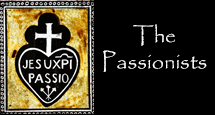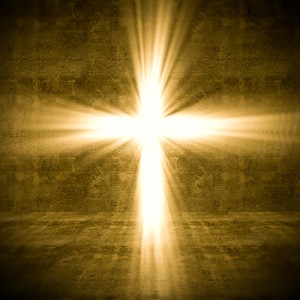Prayers
We pray as Jesus did. How did he pray? He prayed from the heart, yet Jesus used words and signs– sometimes even cries– to pray. Like him, we also use words and signs in prayer.
One prayer we pray frequently is the Sign of the Cross.
The Sign of the Cross goes back to the earliest days of Christianity. It’s made on us at baptism, when we become members of the church and it’s the last sign made over us as we pass to our future life. The Sign of the Cross is used in liturgical prayer and celebrating the sacraments. We begin and end our prayers with it.
When we “bless ourselves” we trace with our hand the figure of the cross on our forehead, our heart, our shoulders, and say:
In the name of the Father, and of the Son, and of the Holy Spirit. Amen.The Sign of the Cross is a prayer of blessing because it symbolizes God embracing us and blessing us. For the Jews God is always One who blesses. God blessed Noah and saved the world from the flood. God blessed Abraham and Sara with blessings more than the stars in the sky. God blessed the Jewish people, redeeming them from the slavery of Egypt. Life itself and all creation are blessings from God. And God’s blessings, beyond measure, continue, always and everywhere.
Since God blesses us continuously, we bless God in return. “I will bless the Lord at all times,” the psalmist says.
As Christians we bless God who is Father, Son and Holy Spirit. As Father, God offers us the blessings of creation and also gives us his Son. “Blessed be God, the Father of our Lord Jesus Christ, who has bestowed on us in Christ every spiritual blessing.” ( Ephesians1,3 ) Jesus Christ is our God, our Friend, our Brother, our Savior. With the Father he sends the Holy Spirit “to complete his work on earth and bring us the fullness of grace.”
When we bless ourselves, we remember God “from whom all blessings flow,” Father, Son and Holy Spirit.
Blessed by the Cross
As Christians we believe the Cross of Jesus Christ is the greatest blessing given to us. Why is it our greatest blessing? Because God expresses his love for us above all in Jesus Christ who died on the Cross for us and rose again. The Sign of the Cross is a reminder that Jesus’ love never ends. His blessings are ours forever.
We express our relationship to God in this simple prayer. We have God’s blessings each day, in good times and bad, in danger and sorrow. God’s blessings and love are always there. Before we take one step, we receive blessings from his hands.
Tenebrae, A Lenten Prayer
Tenebrae, a Holy Week prayer of the western church for Holy Thursday, Good Friday and Holy Saturday, take us to the beginning of the church when believers, meeting in prayer, searched the Jewish scriptures, the psalms, the prophets and other writings, for the meaning of the last days of Jesus. The Passion narratives were formed, in great measure, from this search. Even today they can help us enter the mystery of the Passion of Jesus.
Tenebrae centers around readings from the Jewish scriptures. Jesus told his disciples they spoke of him and they would find him there. (Luke 24,26-27)
Tenebrae has undergone many changes over the centuries. The Liturgy of the Hours is presently the official form of prayer during Holy Week for the Catholic church, but Tenebrae can be a beautiful alternative prayer. The rite of extinguishing lighted candles during the readings and prayers has been associated with Tenebrae for centuries.
Tenebrae is an adaptable prayer form based on scriptures traditionally associated with the Passion of Jesus. What are they?
Passages from the Book of Isaiah that describe the Servant of God, especially chapters 52,15-53,12, influenced the formation of the Passion narratives. Jesus saw himself as the Servant who would suffer and rise again. The Servant Songs are fitting readings for a Tenebrae service.
Psalm 2i. The structure and language of the Passion narratives are noticeably affected by this psalm; as a prediction of the suffering and triumph of Christ it echoes through the New Testament. This psalm belongs in Tenebrae for Good Friday.
Psalm 68, which also follows a pattern of suffering and salvation, likewise figures in the scriptures originally used in reference to the Passion of Christ. With its references to Jesus own untrustworthy disciples and his enemies, this psalm is particularly appropriate for the events recalled in Tenebrae for Holy Thursday.
Psalm 117, 22 “The stone that the builders rejected has become the cornerstone.” This Is an important testimony to the lack of faith Jesus encounters in his Passion. At the same time, it’s a text promising redemption.
Zechariah 12,10 “They shall look upon him whom they have pierced” points to conversion before the mystery of Jesus on the Cross.
Additional material for Tenebrae can be found in the antiphons and prayers for Holy Thursday, Good Friday and Holy Saturday from the Liturgy of the Hours, especially the Office of Readings. The Letter to the Hebrews is a New Testament reading especially appropriate for this prayer.
The Easter homilies of Melito of Sardis, recently added to the prayers of Holy Week in the Liturgy of the Hours, provide useful material for Tenebrae for Holy Saturday, since they speak of creation itself yearning for its redemption. Holy Saturday is traditionally associated with the Descent of Jesus into the nether world.

